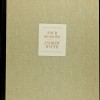In Brief
| Subtitle: | 21 x original lithographs & 21 offset lithographs - private collection |
| Product ID: | 341ART |
| Artist: | Marc Chagall (1887-1985) |
| Title: | Paris opera suite (21 original lithographs and 21 offset lithographs) |
| Type: | Original lithographs and offset lithographs |
| Date: | 1966 |
| Size: | Four page fold out: 24.4 inches x 19 inches | Double page fold out: 19 inches x 12.8 inches | Single page: 12.8 inches x 9.4 inches |
| Condition: | Excellent; minor wear (never framed) |
Interested in this item?
Contact us if you would like to purchase or find out more about this item
Telephone (UK)020 7127 0449
07882 539667
Telephone (International)+44 (0)20 7127 0449
+44 7882 539667
Email[email protected]
Arrange a viewingPlease call to arrange a viewing in Central London
Marc Chagall - the complete Paris opera suite - 21 vintage lithographs - c1966
21 x original lithographs & 21 offset lithographs - private collection
In 1963, Marc Chagall was commissioned to paint the new ceiling for the Paris Opera, a majestic 19th century building and national monument. André Malraux, France's Minister of Culture wanted something unique and decided Chagall would be the ideal artist.
This is the complete Paris Opera suite, comprising 21 original vintage lithographs and 21 offset lithographs. The suite is produced on quality stock and was published in 1966 by Frederick A Praeger, New York, as part of a book. Some of the prints have text or other images on the reverse.
We have attached 16 images of a selection of the art works and if you scroll down you will see them all. The suite comprises a four page fold out (24.4 inches x 19 inches), double page fold outs (19 inches x 12.8 inches), single pages (12.8 inches x 9.4 inches) and some half page images. You will see from our photos some of the works included in the suite.
Original lithographs:
Colour: 9
Black & one colour: 12
Offset lithographs:
Colour: 9
Black & white: 12
If sold individually the lithographs would sell for hugely more than the price we are asking for the set - London art galleries charge hundreds of pounds for a single Chagall lithograph. And of course it is an opportunity to acquire the whole set from one original owner.
This beautiful suite of art comes from the private collection of Stephen Baring. The collection comprises two inherited collections plus twenty five years of personal collecting.
A lithograph is not just a cheap mass produced print. The process dates from 1796 and is far more complicated and therefore valuable. Lithography is a method for printing using a stone (lithographic limestone) or a metal plate with a completely smooth surface. Invented in 1796 by German author and actor Alois Senefelder as a method of publishing theatrical works, lithography can be used to print text or artwork onto paper or other suitable material.
Lithography originally used an image drawn (etched) into a coating of wax or an oily substance applied to a plate of lithographic stone as the medium to transfer ink to a blank paper sheet, and so produce a printed page. In modern lithography, the image is made of a polymer coating applied to a flexible aluminium plate. To print an image lithographically, the flat surface of the stone plate is roughened slightly etched and divided into hydrophilic regions that accept a film of water, and thereby repel the greasy ink; and hydrophobic regions that repel water and accept ink because the surface tension is greater on the greasy image area, which remains dry. The image can be printed directly from the plate (the orientation of the image is reversed), or it can be offset, by transferring the image onto a flexible sheet (rubber) for printing and publication.
A beautiful and valuable suite of lithographs that will be much admired framed in your home or office. Will provide an excellent financial investment as well as a possession to enjoy. You are welcome to return for a full refund if you are not entirely happy. Also, please feel free to view at our central London showroom.



